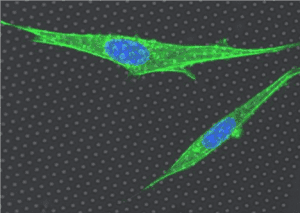
The ability of animal cells to crawl, change their shape, and respond to applied force is due to their cytoskeleton: a dynamic, cross-linked network of actin protein filaments and myosin motors. Our lab has recently created a method to measure cytoskeletal motion, forces, and rheology with high precision and statistical power, using substrates containing arrays of flexible microscopic posts. Our most recent results show that the active nanoscale fluctuations of the cortex form a single continuous spectrum that is non-Gaussian and heavy-tailed. The form of this spectrum provides a window into the distributions of energies and tensions within the living cortex that will inform and constrain future physics-based cytoskeleton models.
- “Lévy distributed fluctuations in the living cell cortex,” S. Sivarajan, Y. Shi, K. M. Xiang, C. Rodríguez-Cruz, C. L. Porter, G. M. Kostecki, L. Tung. J. C. Crocker, and D. H. Reich, arXiv:2309.06226.
- “Measuring cytoskeletal mechanical fluctuations and rheology with active micropost arrays,” Y. Shi, S. Sivarajan, J. C. Crocker, and D. H. Reich, Current Protocols 2, e433 (2022).
- “Pervasive cytoquakes in the actomyosin cortex across cell types and substrate stiffness,” Y. Shi, S. Sivarajan, K. M. Xiang, G. M. Kostecki, L. Tung, J. C. Crocker, and D. H. Reich, Integrative Biology 13, 246-257 (2021).
- Dissecting fat-tailed fluctuations in the cytoskeleton with active micropost arrays, Y. Shi, C. L. Porter, J. C. Crocker, and D. H. Reich, Proc. Nat. Acad. Sci., 116, 13839-13846 (2019).
